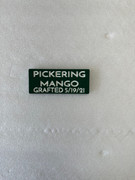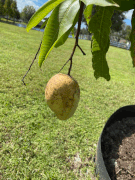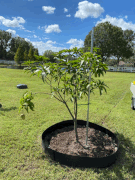I have started machining custom tropical plant signs.
The standard signs are 5.50" wide and 2.25" high. They are machined from
marine grade material that is 1/4" thick for additional stability and durability.
These signs are engraved, not printed and currently I am only machining these in the green color showing in the pictures with the white text. This color combination is good for visibility without showing a lot of dust and dirt. They can easily be cleaned with a little soap and water.
The top of the mounting post is aluminum and angled at the top for improved viewing. Stainless steel fasteners are included to attach the sign to the mounting post.
Standard 2 line signs similar to those shown are $9.00 each plus shipping. Signs like this which include only the plant type and variety will be the same pricing.
Please contact me about pricing for signs similar to the picture showing grafting or other additional text.
It is best to contact me via email
jagmanjoe@gmail.com with any questions including payment, shipping costs, etc.













